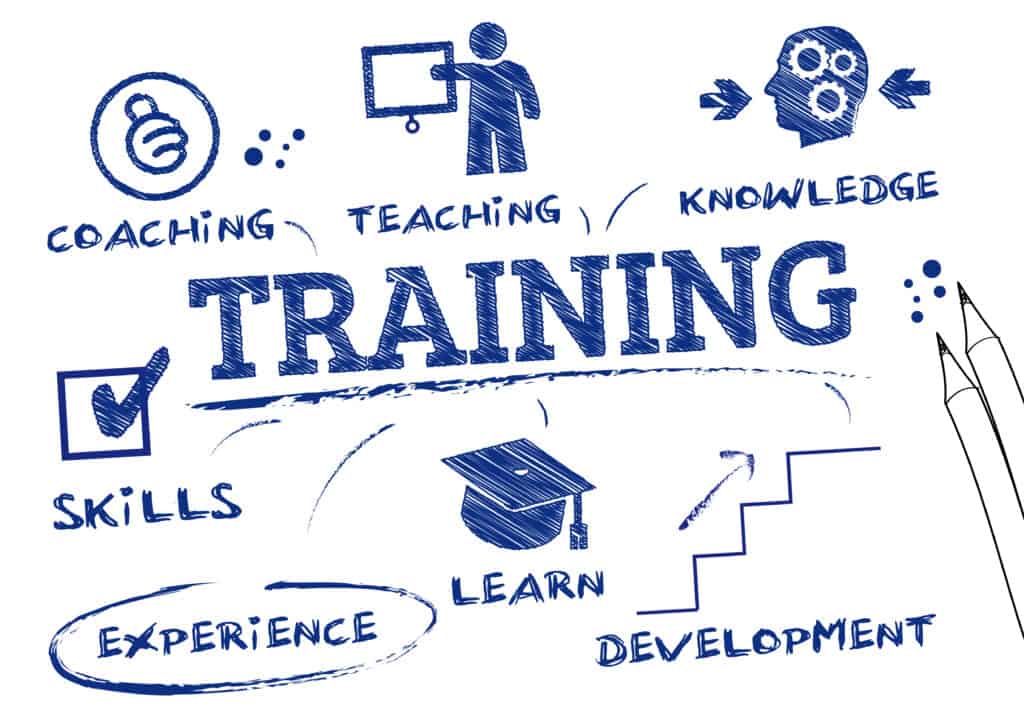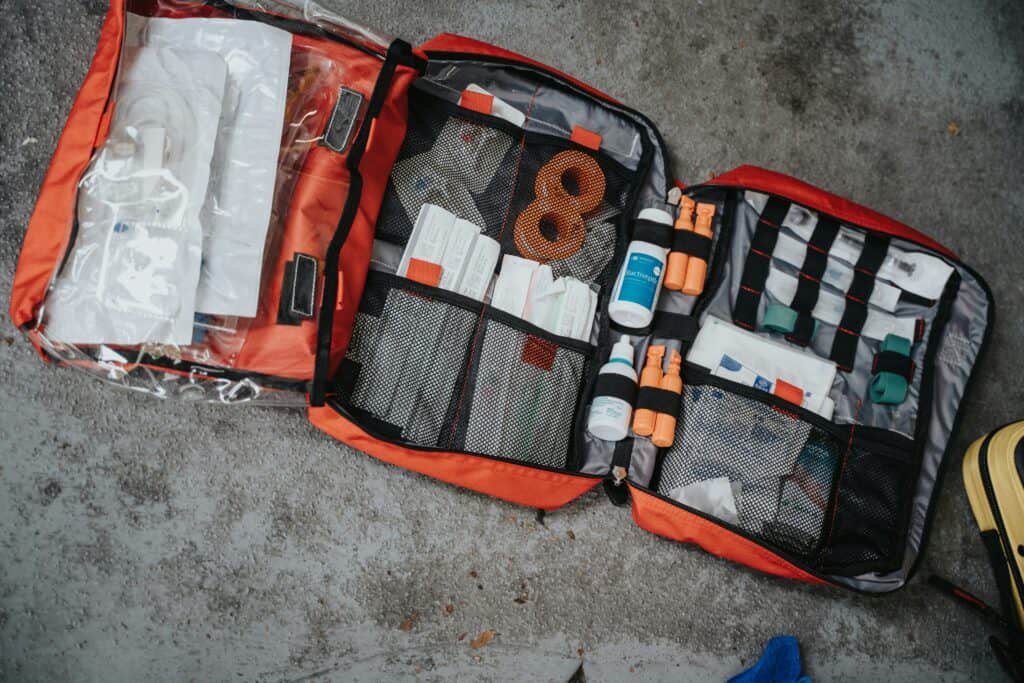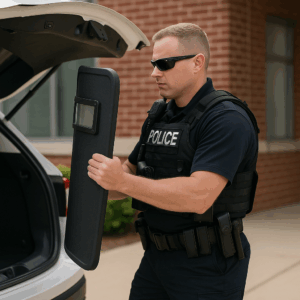Force-on-force training has gained recognition as an essential component of firearms and self-defense education. This training method involves engaging with real people who role-play as potential threats while using firearms that fire non-lethal projectiles. The goal is to create a realistic and high-stress environment, allowing trainees to experience and respond to threat scenarios in a controlled setting.
By simulating real-life situations, force-on-force training provides numerous benefits that traditional flat-range target shooting cannot offer. Trainees develop crucial decision-making skills, effective communication, and the ability to react under pressure. This training method has proved to be significantly superior to traditional (standard) firearms training, inducing stronger physiological stress reactions in trainees and providing a more effective learning experience.
The increasing popularity of force-on-force training among law enforcement agencies, military personnel, and civilians highlights the need for a comprehensive understanding of its importance. The training’s ability to bridge the gap between flat-range practice and real-world encounters further emphasizes its value in preparing individuals for potentially life-threatening situations.
Fundamentals of Force-on-Force Training
Force-on-Force (FOF) training is a critical component in preparing individuals for real-life situations involving firearms and self-defense. This training approach goes beyond traditional target shooting by incorporating scenario-based exercises and role-players to create a more realistic and immersive learning experience.
FOF training utilizes specialized equipment, typically firearms that fire non-lethal projectiles, to engage with real people acting as potential threats. This type of training provides an opportunity for trainees to build decision-making skills, practice appropriate use of force, and better understand the dynamics of a high-stress situation.
One of the primary benefits of scenario-based training is exposing trainees to the unpredictable nature of human adversaries. Unlike stationary paper targets, role players can move, react, and make decisions, allowing trainees to develop a more comprehensive understanding of what it takes to effectively respond to a threat.
Additionally, FOF training helps participants develop important psychological and physiological coping mechanisms for dealing with the stress of a life-threatening situation. Research shows that force-on-force training stimulates a stronger stress reaction in officers, better preparing them for the actual experience they may encounter in the field.
Incorporating role players in FOF exercises allows trainees to confront more complex situations, such as navigating conflicts with multiple participants or implementing de-escalation tactics. This approach also enables trainees to practice proper communication and teamwork, as they learn to coordinate their efforts with others and effectively respond to rapidly evolving scenarios.
Incorporating force-on-force training into a comprehensive self-defense curriculum is essential for developing crucial decision-making skills, understanding the unpredictable nature of human adversaries, and building effective responses to high-stress situations. This type of training provides an invaluable opportunity for individuals to hone their abilities and better prepare for real-life encounters.
Benefits of Force-on-Force Training
Force-on-force training is an essential component of preparing individuals, such as law enforcement officers, police, civilians, and volunteers, for real-life self-defense scenarios. This training approach provides a range of potential benefits, impacting both physical and cognitive skills, as well as addressing the challenges posed by stress and fear.
One of the primary advantages of force-on-force training is that it enables trainees to practice tactics and decision-making in realistic, high-stress situations. By closely replicating the conditions they may encounter, this training method helps participants develop an instinctive ability to make rapid, effective decisions when confronted with violent or dangerous scenarios. As highlighted in a study on force-on-force training, this approach produces a stronger physiological stress reaction in targeted officers compared to traditional firearms practice, resulting in better overall preparedness.
Another benefit lies in the focus on managing stress, as force-on-force training exposes participants to the physical symptoms associated with anxiety and fear. This includes sensations such as pain, tunnel vision, and auditory exclusion, all of which can be debilitating for those unaccustomed to handling high-pressure situations. Through regular exposure to these simulated environments, trainees can become desensitized to these stress responses, allowing them to remain calm and focused under pressure.
By adopting a more realistic training approach, force-on-force exercises offer essential opportunities for feedback and refinement of skills. Unlike traditional training methods such as static shooting ranges, these scenarios involve interaction with role players simulating potential adversaries. This interaction allows trainees to recognize and correct any errors or weaknesses in their tactics, positioning, and use of force to make necessary adjustments based on real-world challenges.
Overall, force-on-force training provides a comprehensive and practical method for enhancing vital skills for law enforcement, police, civilians, and volunteers alike. By exposing participants to realistic, high-stress situations, this training approach fosters improved decision-making, stress management, and tactical skills that prove invaluable when faced with real-life threats.
Training Scenarios and Experiences
Force-on-force training scenarios are designed to simulate real-life situations, putting trainees in situations that mimic the stress and fear they would experience in actual self-defense encounters. The goal of these scenarios is to prepare individuals for the unpredictable nature of violent encounters, helping to increase their confidence and decision-making skills in life-threatening situations.
One common force-on-force scenario might involve an attacker armed with a knife, approaching a trainee in a convenience store setting. This type of situation requires quick responses and appropriate actions to protect oneself and potentially neutralize the attacker. By practicing these scenarios, trainees can develop a better understanding of the most effective strategies in such encounters.
Another possible training scenario could involve an ATM robbery, where an individual is being threatened by an armed assailant. In this case, the trainee must learn how to balance compliance with appropriate self-defense tactics to avoid harm and protect their well-being.
These force-on-force training scenarios are often conducted using realistic props and equipment, such as non-lethal ammunition, to add authenticity to the experience. This helps ensure that trainees become accustomed to the physical and emotional demands of violent encounters, while also learning effective techniques to stay safe and protect others.
While participating in these training scenarios, it is essential for trainees to maintain a neutral and clear mindset, focusing on honing their skills in a safe and controlled environment. This allows for a confident and knowledgeable approach to real-life self-defense situations, ultimately improving their overall safety and effectiveness.
Force-on-force training is a valuable tool to help individuals better prepare for the unexpected nature of self-defense situations. By consistently engaging in realistic training scenarios, trainees can develop the skills and mindset necessary to effectively handle a wide range of violent encounters.
Simunitions and Marker Rounds
One vital aspect of this type of training is the use of Simunitions and marker rounds. These non-lethal training tools provide a unique experience, mimicking the feel and function of live ammunition while ensuring participants’ safety.
Simunitions is one of the more well-known brands in the world of force-on-force training. They offer a variety of training ammunition and conversion kits that allow firearms to fire non-lethal rounds. This system has become increasingly popular among law enforcement and military communities due to its realistic and safe nature. The Simunition rounds produce recoil, muzzle flip, and signature marking, which adds an extra level of realism to the training.
Similar to Simunitions, marker rounds from UTM (Universal Training Munitions) are another type of non-lethal training ammunition. Both UTM and Simunitions rounds function similarly, offering the same benefits. The primary distinction between the two is the marking agent used. Marker rounds from both manufacturers leave a distinctive mark upon impact, allowing participants to assess the accuracy and effectiveness of their shots.
Paintball guns and airsoft are also viable alternatives for force-on-force training. While not as realistic as Simunitions or UTM rounds, they still offer a level of force-on-force engagement. They can be an affordable option for those looking to add some realism to their training without investing in high-priced conversion kits or specialized ammunition.
In conclusion, Simunitions, UTM marker rounds, airsoft, and paintball guns all provide valuable means of force-on-force training. These tools help simulate realistic scenarios, allowing trainees to develop their skills in a safe and controlled environment. By using these non-lethal training tools, individuals can build their confidence, decision-making abilities, and overall effectiveness in real-life situations.
Firearms and Equipment in FOF Training

Participants utilize handguns and rifles modified to fire non-lethal ammunition, such as airsoft or paintball rounds. These simulated firearms provide a safe yet authentic experience for the trainee, enabling better development in grip, drawing from the holster, and shooting accuracy.
In FOF exercises, concealment plays a critical role, teaching participants how to effectively hide themselves and their firearms from potential threats. Trainees learn to navigate challenging self-defense situations, identify cover, and practice movement between positions.
Working with moving targets is another essential component of FOF training. As opposed to static range shooting, FOF scenarios involve unpredictable target movement, forcing participants to adapt and improve their marksmanship skills. This aspect of training is vital for preparing individuals to face real-world situations, where threats are unlikely to remain stationary.
In addition to firearms and concealment, proper stance and body movement are fundamental to FOF training. Participants learn to shoot while on the move, honing their footwork and body positioning to maximize stability and accuracy. These skills are indispensable for individuals seeking to become proficient marksmen and excel in high-stress gunfight scenarios.
In conclusion, firearms and equipment play a significant role in FOF training. The use of simulated firearms, proper concealment techniques, and training with moving targets allow individuals to develop essential self-defense skills in a safe yet realistic environment. By focusing on stance, body movement, and marksmanship, FOF training prepares participants to handle real-life gunfight situations with confidence and skill.
Safety and Protection During Training
A key aspect of this type of training is the importance of ensuring safety and proper protection for all participants.
To begin with, it’s important to prevent the use of live ammunition during training exercises. Instead, Simunition-type marking cartridges should be employed, which allows officers to engage with a human adversary in a controlled environment. Unlike traditional marksmanship training, with paper targets and static shooting positions, force-on-force training exposes officers to the realities of high-stress scenarios and threats that can emerge from various directions.
Safety gear is essential for all participants in force-on-force training. This includes the officers themselves, role players, instructors, and safety officers. At a minimum, individuals involved in the training should have impact-resistant full-face protection, which covers the forehead, eyes, nose, mouth, and chin. This ensures that their face and eyes are protected from potential harm. Furthermore, gloves can be used to protect participants’ hands during training exercises.
It’s also crucial for proper gun handling and safety procedures to be followed at all times. Participants must be aware of their surroundings and the potential risks involved with force-on-force training. A safety officer should be present to ensure that all participants follow safety procedures and to intervene if a situation becomes unsafe or someone is about to be injured.
Training scenarios must be carefully planned, with clearly defined learning objectives that focus on the desired outcomes for the students. This will help guide the construction and execution of the training scenario, ensuring that the training is not only effective but also safe for all involved.
The importance of safety and protection during force-on-force training cannot be understated. By employing the appropriate safety measures and gear, officers can fully engage in training that accurately simulates real-world situations while minimizing the risk of injury.
Building Confidence and Mindset in Trainees
One essential aspect of this training is its ability to inoculate trainees against the effects of adrenaline and fear. During force-on-force exercises, trainees undergo physiological stress reactions, enabling them to better manage their adrenaline response when faced with actual threats. As a result, their decision-making abilities and use of force become more refined and accurate in real-life situations.
In addition to managing adrenaline and fear, force-on-force training provides trainees with invaluable hands-on experience. By participating in scenarios that closely mimic the challenges they may come across in their line of work, trainees can hone their skills and develop the ability to make quick, well-informed decisions under pressure. This type of training experience builds their confidence in handling potentially dangerous situations.
Furthermore, force-on-force training emphasizes the development of a proactive mindset among trainees. They learn to be constantly aware of their environment, ready to assess potential threats and react appropriately. This mindset not only boosts their confidence but also helps improve their effectiveness in stressful situations.
Force-on-force training plays an essential role in building confidence and developing a strong mindset in trainees. By exposing them to realistic scenarios, trainees learn to manage adrenaline and fear, gain hands-on training experience, and cultivate a proactive mindset. This results in more confident and effective individuals in high-pressure situations.
Force-on-Force Classes and Evaluation
Force-on-force (FOF) classes offer practical training for those seeking an advanced understanding of self-defense with firearms. These courses place participants in realistic scenarios, allowing them to engage with real-life threats using simulated firearms and non-lethal projectiles. The training aims to replicate the stress and fear experienced during life-threatening situations, providing participants with a more authentic learning environment than traditional target shooting on a flat range.
Evidence from a recent study confirms the benefits of FOF training over traditional target training in at least three significant ways:
- Experiencing a stronger physiological stress reaction in targeted officers due to FOF scenarios.
- Enhancing decision-making skills under stress and pressure.
- Improving firearms proficiency and accuracy.
When evaluating FOF classes, it’s essential to consider the course’s objectives and the instructor’s experience. Instructors should have a solid background in firearms training and be knowledgeable in real-world tactical situations. Additionally, it is crucial to confirm that the course provides a safe training environment where participants can practice with non-lethal ammunition.
Class participants can expect to experience various situations during FOF training, such as:
- Confronting an active shooter.
- Defending against a home invasion.
- Engaging with multiple attackers.
Furthermore, FOF classes should offer an organized structure and a well-planned curriculum. This can include classroom lectures on firearm safety and situational awareness, followed by scenario-based exercises that put participants’ knowledge and skills to the test.
Force-on-force training is an essential component of comprehensive self-defense firearms education. It offers real-world scenarios that challenge participants in ways that traditional target shooting cannot provide. By participating in FOF classes, individuals can build their confidence, enhance their decision-making skills, and refine their firearm proficiency under high-stress situations.
Frequently Asked Questions
What are the key components of effective force-on-force training?
Effective force-on-force (FOF) training involves scenario-based exercises that simulate real-life situations, inducing fear and stress to better prepare participants for genuine threats. Key components include realistic role-playing, utilization of non-lethal ammunition, and continuous adaptation based on potential scenarios that one may encounter on and off the range.
How does force-on-force training improve preparedness?
FOF training improves preparedness by exposing participants to the unpredictability and speed of human adversaries, which traditional target shooting cannot achieve. The hands-on, dynamic nature of these exercises provides invaluable experience in decision-making, situational awareness, and effective firearm handling under stress when faced with a life-threatening situation.
What is the role of equipment and technology in force-on-force training?
Equipment and technology play a crucial role in FOF training by offering realistic, yet safe simulation for participants. Non-lethal ammunition and specially designed firearms ensure safety while still providing-authentic practice. Additionally, advanced technologies, such as virtual reality or computer simulations, can offer even more immersive and customizable experiences.
How do force-on-force training exercises differ from traditional training methods?
Traditional training methods, like target shooting, focus on building fundamental firearm skills, whereas FOF training emphasizes experiencing real-world scenarios. By engaging in role-playing exercises with other participants, individuals develop essential skills in decision-making and problem-solving under high-stress conditions, making FOF training far more effective in preparing for actual encounters.
How are civilian instructors integrated into force-on-force training programs?
Civilian instructors with specialized skills and experience are often brought in to enhance FOF training programs. These instructors may come from a variety of backgrounds, such as law enforcement, military, or self-defense training, and contribute to the program by offering different perspectives, techniques, and best practices. Integration of civilian instructors ensures that participants receive diverse, well-rounded perspectives on handling real-life threats and scenarios.
What safety measures are in place during intensive force-on-force training exercises?
Safety is a priority during FOF training exercises. Participants use non-lethal ammunition and firearms designed for training purposes, reducing the risk of injury. Moreover, strict range safety protocols are implemented, which often include wearing protective gear, establishing clear rules of engagement, and having qualified instructors oversee the exercises. Constant supervision and monitoring, combined with the use of specialized equipment, ensure that participants safely experience realistic training scenarios.








